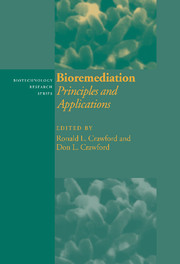Book contents
- Frontmatter
- Contents
- List of contributors
- Preface
- Introduction
- 1 Engineering of bioremediation processes: needs and limitations
- 2 Bioremediation in soil: influence of soil properties on organic contaminants and bacteria
- 3 Biodegradation of ‘BTEX’ hydrocarbons under anaerobic conditions
- 4 Bioremediation of petroleum contamination
- 5 Bioremediation of environments contaminated by polycyclic aromatic hydrocarbons
- 6 Bioremediation of nitroaromatic compounds
- 7 A history of PCB biodegradation
- 8 Bioremediation of chlorinated phenols
- 9 Biodegradation of chlorinated aliphatic compounds
- 10 Microbial remediation of metals
- 11 Molecular techniques in bioremediation
- Index
8 - Bioremediation of chlorinated phenols
Published online by Cambridge University Press: 28 October 2009
- Frontmatter
- Contents
- List of contributors
- Preface
- Introduction
- 1 Engineering of bioremediation processes: needs and limitations
- 2 Bioremediation in soil: influence of soil properties on organic contaminants and bacteria
- 3 Biodegradation of ‘BTEX’ hydrocarbons under anaerobic conditions
- 4 Bioremediation of petroleum contamination
- 5 Bioremediation of environments contaminated by polycyclic aromatic hydrocarbons
- 6 Bioremediation of nitroaromatic compounds
- 7 A history of PCB biodegradation
- 8 Bioremediation of chlorinated phenols
- 9 Biodegradation of chlorinated aliphatic compounds
- 10 Microbial remediation of metals
- 11 Molecular techniques in bioremediation
- Index
Summary
Chlorophenols are common environmental contaminants originating mainly from their use as wide-spectrum biocides in industry and agriculture, their formation during pulp bleaching and the incineration of organic material in the presence of chloride. Chlorophenol use as biocides has resulted in soil and groundwater contamination; pulp bleacheries discharge wastewaters into aquatic environments; and combustion results in the contamination of all environmental compartments. Chlorophenols have the potential of being biotransformed and/or mineralized in both aerobic and anaerobic systems and degradation pathways have been carefully delineated. In aquatic and terrestrial environments chlorophenols become bound to humic materials, affecting their bioavailability, and possibly offering a useful method of detoxification. Although chlorophenols persist in many environments, because of inappropriate conditions for biodegradation, biological methods have been utilized in groundwater and soil remediation of chlorophenols. Composting and landfarming are the most common soil remediation methods, while on-site bioreactors are used for groundwater remediation. In situ bioremediation for restoration of contaminated subsurface environments has gained significant interest and the first full-scale operations are in progress. The fate of chlorophenol contaminants in aquatic sediments has been widely studied and the results serve as a basis of future efforts in remediation of sediments.
Sources of contamination
The forest industry has used extensive amounts of chloropheols (CPs) for the preservation of timber against blue sapstain fungi. In the U.S., pentachorophenol (PCP) ia mainly used (Cirelli, 1978), while in Europe and Japan, various CP congener mixtures are typical. Preservative solutions are prepared either by dissolution of CPs in sodium hydroxide to produce concentrated chlorophenate solutions, or dissolution in fuel oil or kerosene. If these solvents are not available, liquid petroleum gas, methylene chloride, isopropyl alcohol, or methanol are used.
- Type
- Chapter
- Information
- BioremediationPrinciples and Applications, pp. 254 - 299Publisher: Cambridge University PressPrint publication year: 1996
- 14
- Cited by



